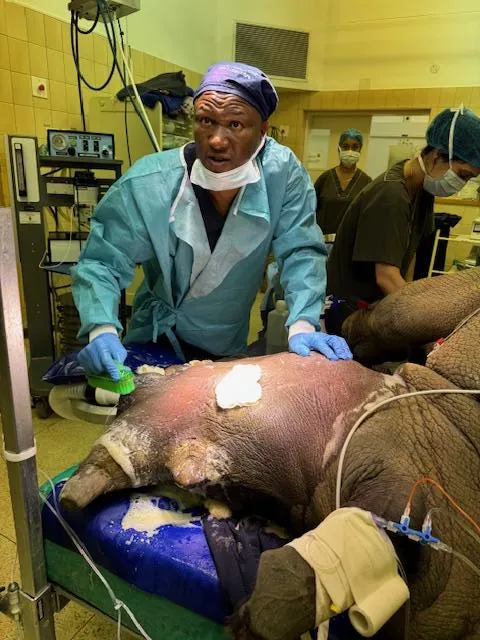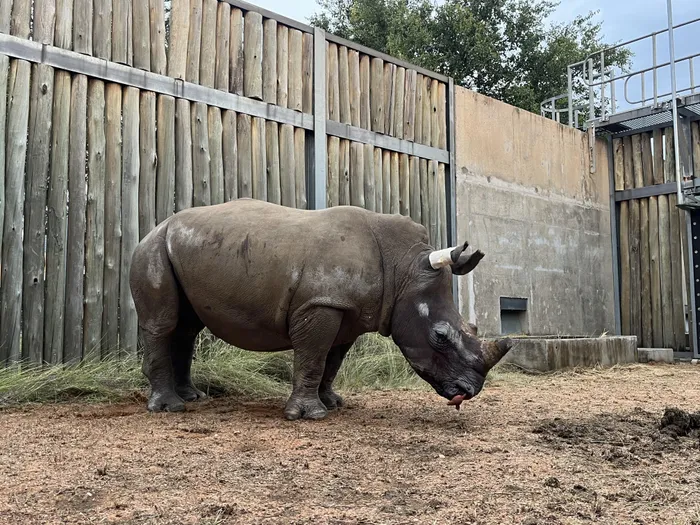Houdini the rhino: a life-saving surgery by the University of Pretoria's veterinary team

Solly Mapaya assisted with washing and cleaning the surgical site for the operation
Image: University of Pretoria
A veterinary team from the University of Pretoria’s (UP) Faculty of Veterinary Science has achieved a remarkable feat, giving four-year-old white rhino bull Houdini a ‘breath of life’ after performing a complex surgical procedure.
This intricate surgery, lasting over five hours, was necessitated by a severe nasal obstruction resulting from a harrowing poaching incident years ago, which saw Houdini shot through the nose.
After the traumatic experience, Houdini found refuge at The Rhino Orphanage in Limpopo under the careful supervision of veterinarian Dr Pierre Bester. Initial signs of healing turned troubling when Houdini began to struggle to breathe through one nostril, prompting further investigation. A nasal endoscopy revealed pink tissue obstructing his right nasal passage, threatening Houdini's ability to breathe—a situation that Dr Bester highlighted as critical, given that rhinos breathe exclusively through their noses.
In a bid to preserve Houdini’s quality of life, Dr Bester referred him to Professor Gerhard Steenkamp, a veterinary specialist in dentistry and maxillofacial surgery. A CT scan painted a grim picture: the lesion was not only blocking Houdini’s right nasal passage but was also encroaching upon the left. The imaging revealed new bone forming in his nose as a consequence of the old gunshot wound, complicating Houdini’s already critical situation.
Considering the extensive size of the lesion, the team, led by Prof Steenkamp and specialist equine surgeon Dr Elza Hollenbach, decided upon an open surgery to rectify the situation, as low-invasive approaches were deemed unfeasible. “We knew we had to act fast,” Prof Steenkamp stated. “This wasn’t just about clearing a nasal passage; it was about giving Houdini back his ability to live a normal life.”

Houdini the rhino recovering after his lifesaving surgery
Image: University of Pretoria
Prior to the surgery, Houdini underwent a series of recovery procedures necessary for his overall health. When he was deemed fit, specialist wildlife veterinarian Dr Jacques O'Dell administered a careful combination of anaesthetic drugs to ensure the rhino would be stable for the procedure ahead.
The surgery was fraught with challenges, not least the significant anaesthetic risks posed by Houdini’s compromised breathing capacity. “These animals, even healthy ones, often suffer from severe cardiopulmonary complications under sedation,” Dr O'Dell explained. The team proceeded with caution, optimising Houdini’s condition to mitigate any danger during the lengthy operation.
The surgical team employed innovative techniques under pressure, including a pioneering haemodilution method to manage potential blood loss, as fresh blood transfusion was unavailable. This technique—collecting a significant proportion of Houdini's own blood to reduce the risk of complications—had not previously been reported in rhinos but had been found effective in other animal surgeries.
“All in all, we successfully kept Houdini asleep for 5 hours and 55 minutes without significant complications,” Dr Abdur Kadwa, a specialist veterinary anaesthesiologist, shared with relief. Following the marathon surgery, Houdini was transferred to a qualified wildlife clinic where he was closely monitored.
Within days, Houdini was back on his feet and soon set to return home. Witnessing him walk from the clinic, breathing freely, was an emotional moment for the entire team. “He’s a fighter, and he’s earned every breath,” Prof Steenkamp remarked, reflecting the team's profound commitment to the wellbeing of this endangered species.
Related Topics: